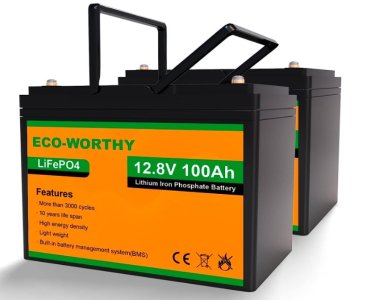stav
Member
Hi All, HNY.
Before the festive season I was lured by a black Friday deal and bought two Lipo batteries for a good price. 100Ah each I have also bought a 60A DC to DC charger.
I have just semi retired (from teaching to being a carpenter) and my pension will kick in in a years time. I then hope to go off sailing for the summers, from UK, to perhaps Spain, Ireland, Scotland etc. ,mostly singlehanded as my family are not interested.
Therefore I was interested in using the powered autohelm as don't feel a windvane is cost effective (although looking to see if I can build one such as the BB design). Also I have a ketch rigged Conway and a windvane will mix up with the mizzen boom.
Therefore I was thinking of getting Lipo batteries to drive the autohelm for up to 24 hours and then be able to recharge the batteries quickly from the engine or a small generator.
Hope that all makes sense?
Currently I have 3x 110AH lead acid in the domestic bank and 1x 100Ah starter battery. There is also an Adverc battery management system which seems to do a good job of keeping them at 100% but I rarely let them discharge below 80%. I also have a good sized shore charger 80 or 100amps??
Therefore I am seeking advice on the best way to incorporate the Lipo in to my system? Currently thinking of taking out two of the domestic LA batteries and putting them together as the starter batteries (to act as reserve domestic if need be and there is space for two batteries in the locker with the one battery).
Then to add the two Lipo batteries to the single LA with a switch between the LA positives and the parallel Lipo each with a separate voltage display to check the voltages are not miles apart? Then engine off connect the switch and run domestic services from the LA and Lipo. Before switching on engine disconnect switch, start engine and DC to DC will charge the lipo batteries (or the shore charger will).
Hope that makes sense. Biggest problem is switch but will change the manual switch for a remote battery switch so can operate from cockpit.
I will add some pictures if I can..................
I have searched the internet and youtube but seem to find so much contradictory advice and most seem to involve solar panels in warm clims...... But looking for a solution for our climate without solar and not needing air-conditioning or freezers.....
Thank you if you have worked through all of that and for any suggestions!!!!!
Before the festive season I was lured by a black Friday deal and bought two Lipo batteries for a good price. 100Ah each I have also bought a 60A DC to DC charger.
I have just semi retired (from teaching to being a carpenter) and my pension will kick in in a years time. I then hope to go off sailing for the summers, from UK, to perhaps Spain, Ireland, Scotland etc. ,mostly singlehanded as my family are not interested.
Therefore I was interested in using the powered autohelm as don't feel a windvane is cost effective (although looking to see if I can build one such as the BB design). Also I have a ketch rigged Conway and a windvane will mix up with the mizzen boom.
Therefore I was thinking of getting Lipo batteries to drive the autohelm for up to 24 hours and then be able to recharge the batteries quickly from the engine or a small generator.
Hope that all makes sense?
Currently I have 3x 110AH lead acid in the domestic bank and 1x 100Ah starter battery. There is also an Adverc battery management system which seems to do a good job of keeping them at 100% but I rarely let them discharge below 80%. I also have a good sized shore charger 80 or 100amps??
Therefore I am seeking advice on the best way to incorporate the Lipo in to my system? Currently thinking of taking out two of the domestic LA batteries and putting them together as the starter batteries (to act as reserve domestic if need be and there is space for two batteries in the locker with the one battery).
Then to add the two Lipo batteries to the single LA with a switch between the LA positives and the parallel Lipo each with a separate voltage display to check the voltages are not miles apart? Then engine off connect the switch and run domestic services from the LA and Lipo. Before switching on engine disconnect switch, start engine and DC to DC will charge the lipo batteries (or the shore charger will).
Hope that makes sense. Biggest problem is switch but will change the manual switch for a remote battery switch so can operate from cockpit.
I will add some pictures if I can..................
I have searched the internet and youtube but seem to find so much contradictory advice and most seem to involve solar panels in warm clims...... But looking for a solution for our climate without solar and not needing air-conditioning or freezers.....
Thank you if you have worked through all of that and for any suggestions!!!!!

